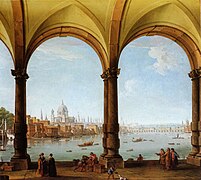Antonio Joli: Difference between revisions
authority control moved to wikidata |
m Bot: Fixing commonscat per Category:Commons category template with no category set. (Report error) |
||
| Line 57: | Line 57: | ||
==External links== |
==External links== |
||
{{Commons category}} |
{{Commons category|Antonio Joli}} |
||
* [http://www.wikigallery.org/wiki/artist38652/Antonio-Joli/page-1 Antonio Joli at Wikigallery.org] |
* [http://www.wikigallery.org/wiki/artist38652/Antonio-Joli/page-1 Antonio Joli at Wikigallery.org] |
||
* [http://libmma.contentdm.oclc.org/cdm/compoundobject/collection/p15324coll10/id/187741/rec/2 ''Italian Paintings, Venetian School''], a collection catalog containing information about Joli and his works (see index; plate 39). |
* [http://libmma.contentdm.oclc.org/cdm/compoundobject/collection/p15324coll10/id/187741/rec/2 ''Italian Paintings, Venetian School''], a collection catalog containing information about Joli and his works (see index; plate 39). |
||
Revision as of 15:53, 16 September 2015
Antonio Joli | |
|---|---|
 Antonio Joli, Departure of Charles III from Naples, Museo del Prado, 1759 | |
| Born | 1700 |
| Died | 29 April 1777 |
| Movement | vedutisti |
Antonio Joli or Ioli (1700 – 29 April 1777) was an Italian painter of vedute and capricci.
Born in Modena, he first was apprenticed to Rafaello Rinaldi. He then studied in Rome under Giovanni Paolo Panini, and in the studios of the Galli da Bibbiena family of scene-painters. He became a painter of stage sets in Modena and Perugia. In 1732 he moved to Venice, where he worked as stage-painter for opera productions at the Teatro di San Giovanni Grisostomo and the Teatro San Samuele of the Grimani family. In 1742 he went to Dresden, and then to London (1744–48) and Madrid (1750–54).[1] In London, he decorated the Richmond mansion of John James Heidegger, then the director of the King's Theatre in the Haymarket.[2] Joli returned to Venice in 1754, where he became one of the 36 founding members of the Accademia di Belle Arti di Venezia. He moved to the Bourbon court of Naples in 1761,[1] and died there on 29 April 1777.
References
- ^ a b Susan Tipton (2010). Diplomatie und Zeremoniell in Botschafterbildern von Carlevarijs und Canaletto (in German). RIHA Journal: International Association of Research Institutes in the History of Art. 2010:0008. URN urn:nun:de:101:1-201010062457. Accessed July 2013.
- ^ Ralph Toledano (2006). Antonio Joli: Modena 1700-1777 Napoli (in Italian). Torino: Artema. ISBN 9788880521006. p. 188.
Further reading
- Links, J. G. (1977). Canaletto and his Patrons. London: Paul Elek. p. 99.
- Grove encyclopedia biography on Artnet
Gallery
-
The departure of the nuncio Stoppani from the Doge's Palace after his audience; National Gallery of Art, Washington
-
The greeting of Nuncio Stoppani, 1741; National Gallery of Art, Washington
-
Rome, A View of the Forum with the Campo Vaccino, the church of Santa Francesca and the Colosseum
-
Prospect of London
External links
- Antonio Joli at Wikigallery.org
- Italian Paintings, Venetian School, a collection catalog containing information about Joli and his works (see index; plate 39).




